check engine CHEVROLET LUMINA 1993 1.G Workshop Manual
[x] Cancel search | Manufacturer: CHEVROLET, Model Year: 1993, Model line: LUMINA, Model: CHEVROLET LUMINA 1993 1.GPages: 324, PDF Size: 17.44 MB
Page 243 of 324
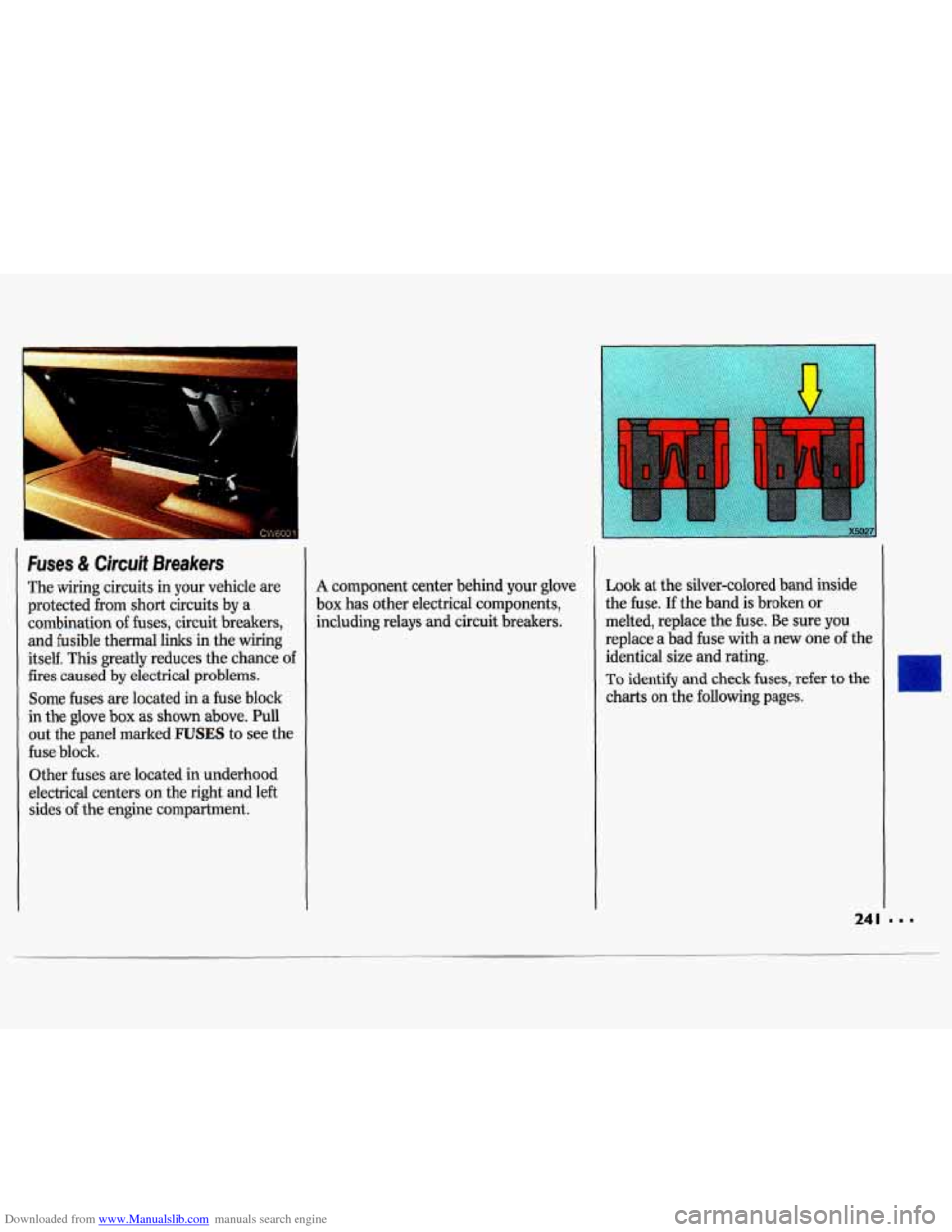
Downloaded from www.Manualslib.com manuals search engine Fuses & Circuit Breakers
The wiring circuits in your vehicle are
protected
from short circuits by a
combination of fuses, circuit breakers,
and fusible thermal links in the wiring
itself. This greatly reduces the chance
of
fires caused by electrical problems.
Some fuses are located in a fuse block
in the glove box
as shown above. Pull
out the panel marked
FUSES to see the
fuse block.
Other fuses are located in underhood
electrical centers
on the right and left
sides
of the engine compartment.
I
A component center behind your glove
box has other electrical components,
including relays and circuit breakers. Look at the silver-colored band inside
the fuse.
If the band is broken or
melted, replace the fuse. Be sure you
replace a bad fuse with a new one
of the
identical size and rating.
To identify and check fuses, refer to the
charts on the
following pages.
241
Page 248 of 324
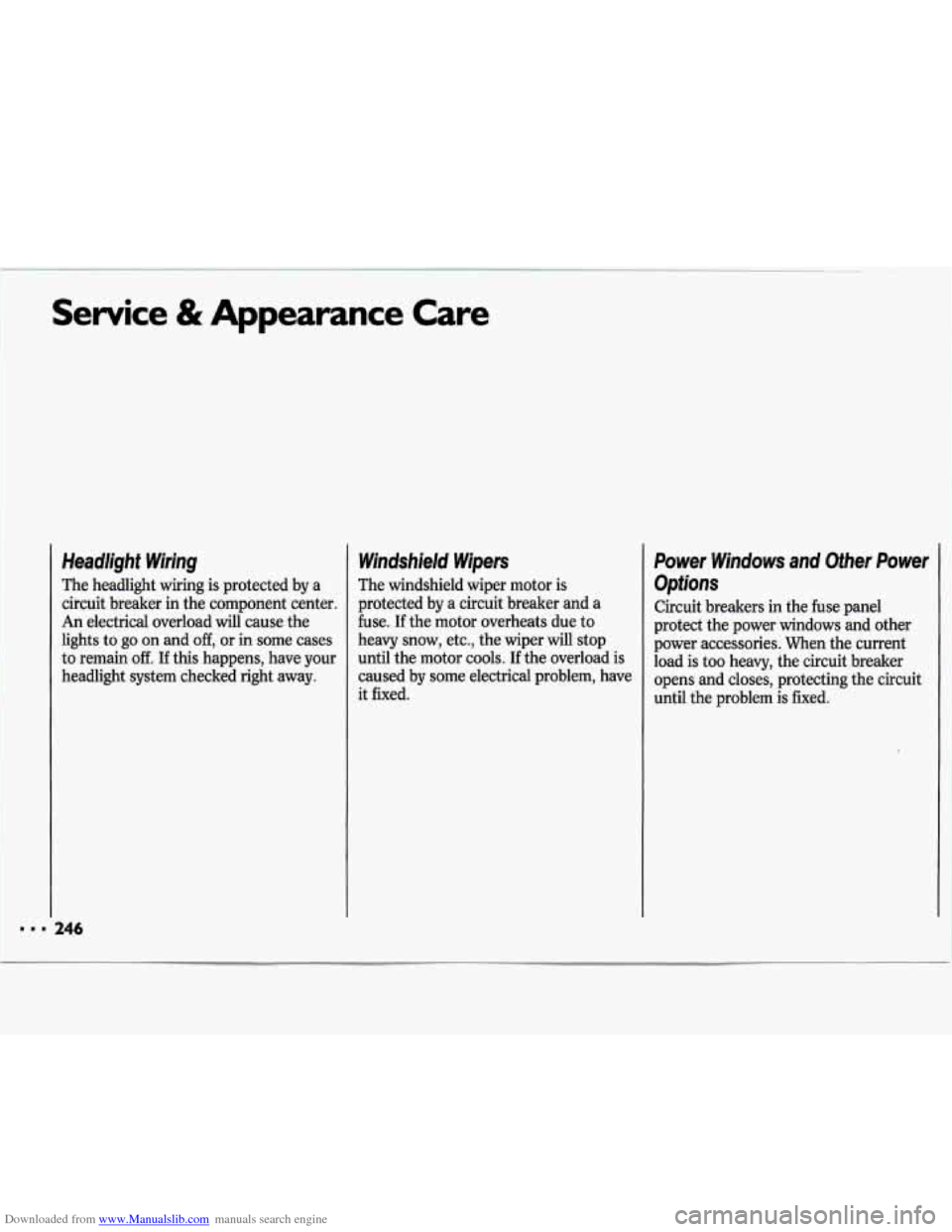
Downloaded from www.Manualslib.com manuals search engine Service & Appearance Care
Headlight Wiring
The headlight wiring is protected by a
circuit breaker in the component center.
An electrical overload will cause the
lights to
go on and off, or in some cases
to remain off. If this happens, have your
headlight system checked right away.
Windshield Wipers
The windshield wiper motor is
protected by
a circuit breaker and a
fuse.
If the motor overheats due to
heavy snow, etc., the wiper will stop
until the motor cools.
If the overload is
caused by some electrical problem, have
it fixed.
Power Windows and Other Power
Options
Circuit breakers in the fuse panel
protect the power windows and other
power accessories. When the current
load
is too heavy, the circuit breaker
opens and closes, protecting the circuit
I
until the problem is fixed.
Page 261 of 324
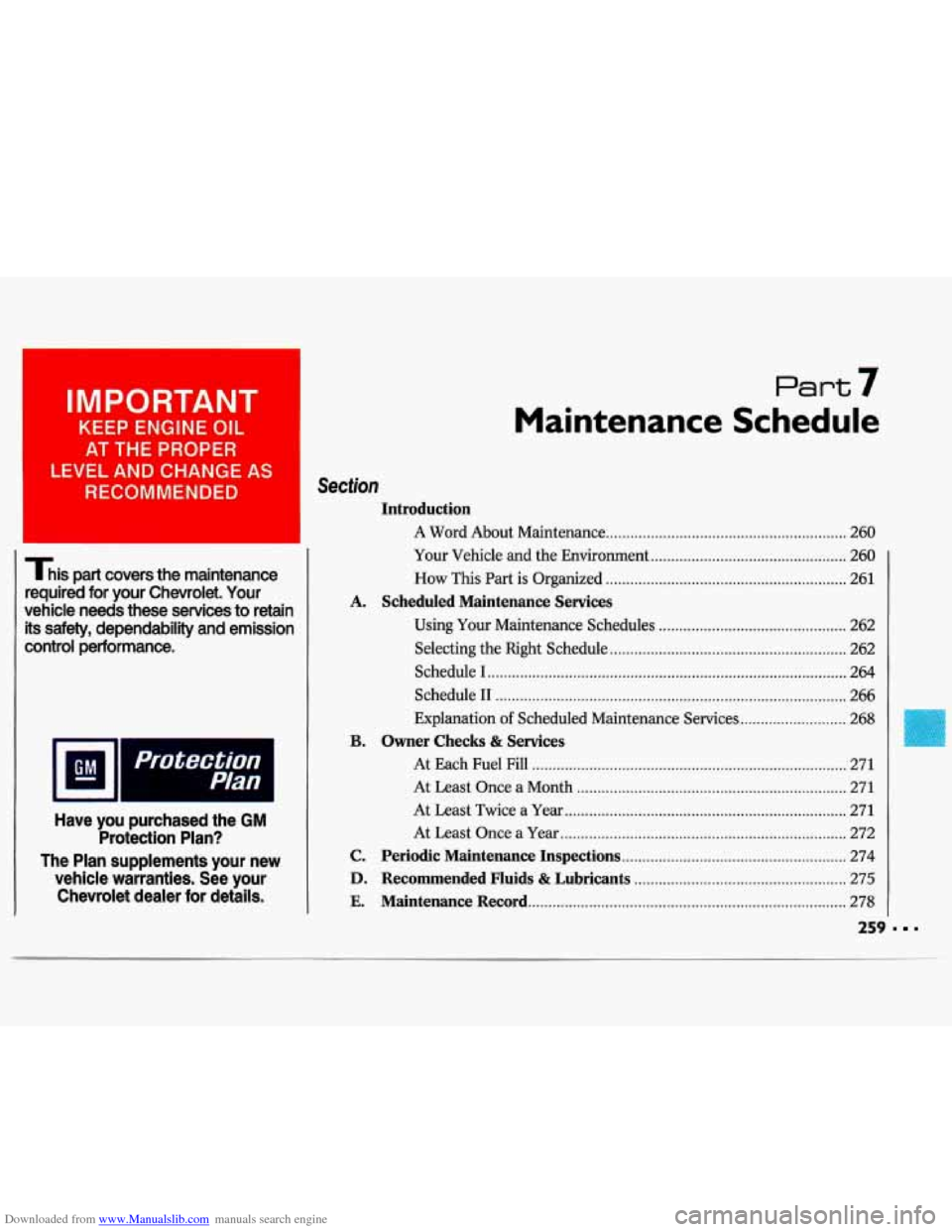
Downloaded from www.Manualslib.com manuals search engine IMPORTANT I
KEEP ENGINE OIL
AT THE PIROPER
LEVEL AND CHANGE AS
RECOMMENDED
I
This part covers the maintenance
required for your Chevrolet
. Your
vehicle needs these services to retain
its safety. dependability and emission
control performance
.
Part 7
Maintenance Schedule
Have you purchased the GM
Protection Plan?
The Plan supplements your new
vehicle warranties
. See your
Chevrolet dealer for details
.
Section
Introduction
A Word About Maintenance ........................................................... 260
Your Vehicle and the Environment
................................................ 260
How This Part is Organized ........................................................... 261
Using Your Maintenance Schedules
.............................................. 262
Selecting the
Right Schedule .......................................................... 262
Schedule
I ........................................................................\
................ 264
Schedule
I1 ........................................................................\
.............. 266
Explanation
of Scheduled Maintenance Services .......................... 268
At Each Fuel Fill
........................................................................\
..... 271
At Least Once a Month
.................................................................. 271
At Least Twice a Year
..................................................................... 271
At Least Once a Year
...................................................................... 272
A . Scheduled Maintenance Services
B . Owner Checks & Services
C . Periodic Maintenance Inspections ....................................................... 274
D . Recommended Fluids & Lubricants .................................................... 275
E . Maintenance Record ........................................................................\
...... 278
259 . .
Page 262 of 324
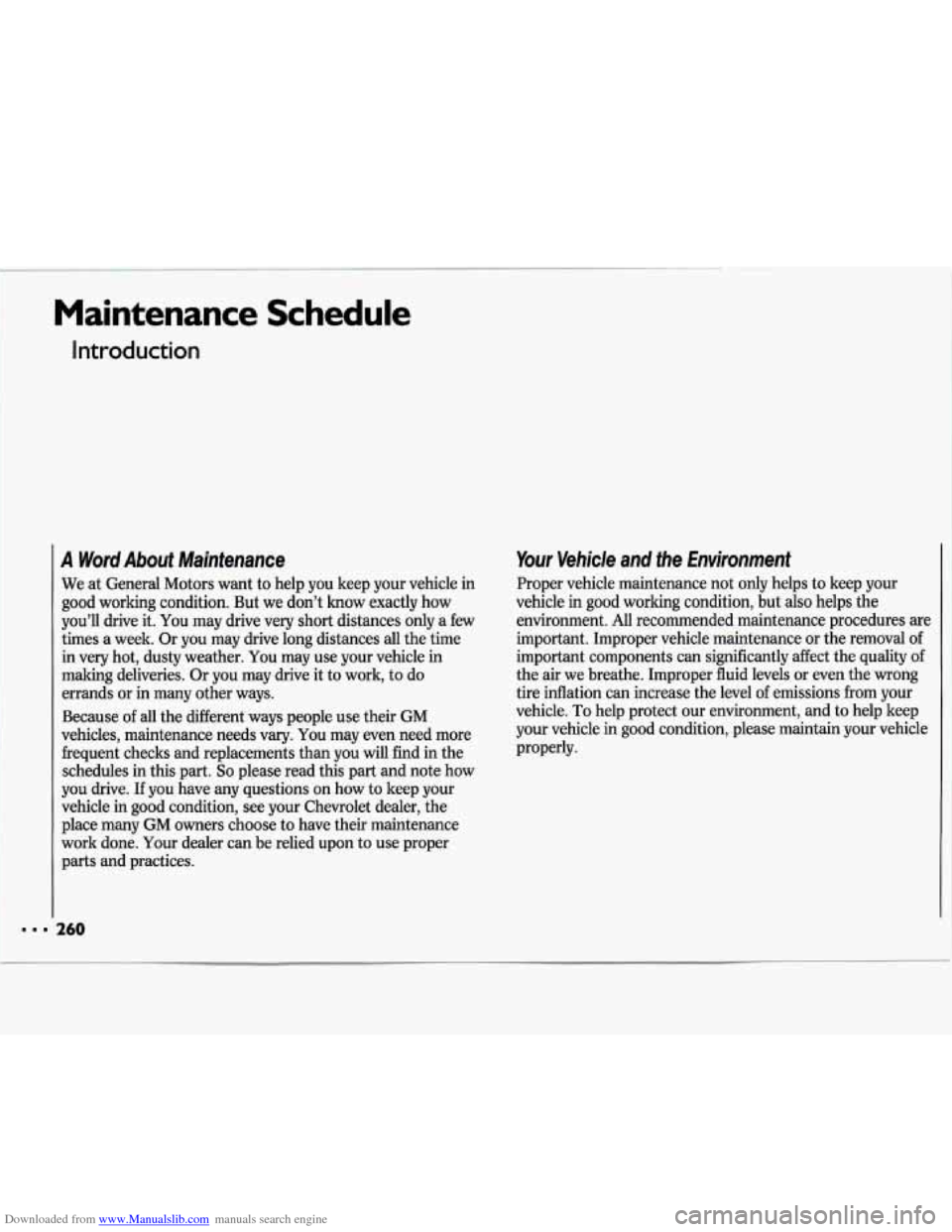
Downloaded from www.Manualslib.com manuals search engine Maintenance Schedule
Introduction
A Word About Maintenance
We at General Motors want to help you keep your vehicle in
good working condition. But we don’t know exactly how
you’ll drive it.
You may drive very short distances only a few
times a week. Or you may drive long distances
all the time
in very hot, dusty weather.
You may use your vehicle in
making deliveries. Or you may drive it to work, to do
errands or in many other ways.
Because
of all the different ways people use their GM
vehicles, maintenance needs vary.
You may even need more
frequent checks and replacements than you
will find in the
schedules in this part.
So please read this part and note how
you drive. If you have any questions on how to keep your
vehicle in good condition, see your Chevrolet dealer, the
place many GM owners choose to have their maintenance
work done. Your dealer can be relied upon
to use proper
parts and practices.
Your Vehicle and the Environment
Proper vehicle maintenance not only helps to keep your
vehicle in good working condition,
but also helps the
environment. All recommended maintenance procedures are
important. Improper vehicle maintenance or the removal of
important components can significantly affect the quality of
the air we breathe. Improper fluid levels or even the wrong
tire inflation can increase the level of emissions from your
vehicle.
To help protect our environment, and to help keep
your vehicle in good condition, please maintain your vehicle
properly.
Page 263 of 324

Downloaded from www.Manualslib.com manuals search engine How This Parf is Organized
The remainder of this part is divided into five sections:
Section
A: Scheduled Maintenance Services shows what to
have done and how often. Some of these services can be
complex,
so unless you are technically qualified and have
the necessary equipment, you should let your dealer’s
service department or another qualified service center do
these jobs.
CAUTION
Performing maintenance work on a vehicle can be
b dangerous. In trying to do some jobs, you can be
senously injured. Do your own maintenance work only
if you have the required
know-how and the proper tools
and equipment for the job. If you
have any doubt, have
a qualified technician do the work.
If you are skilled enough to do some work on your vehicle,
you
will probably want to get the service information GM
publishes.
You will find a list of publications and how to get
them in this manual. See the
Index under Service
Publications.
Section B: Owner Checks & Services tells you what should
be checked whenever you stop for fuel. It also explains what
you can easily do to help keep your vehicle in good
condition.
Section C: Periodic Maintenance Inspections explains
important inspections that your Chevrolet dealer’s service
department or another qualified service center should
perform.
Section
D: Recommended Fluids & Lubricants lists some
products
GM recommends to help keep your vehicle
properly maintained. These products, or their equivalents,
should be used whether you do the work yourself or have it
done.
Section
E: Maintenance Record provides a place for you to
record the maintenance performed on your vehicle.
Whenever any maintenance is performed, be sure to write it
down in this section. This
will help you determine when
your next maintenance should be done. In addition, it is a
good idea to keep your maintenance receipts. They may be
needed
to qualify your vehicle for warranty repairs.
26 I
Page 270 of 324
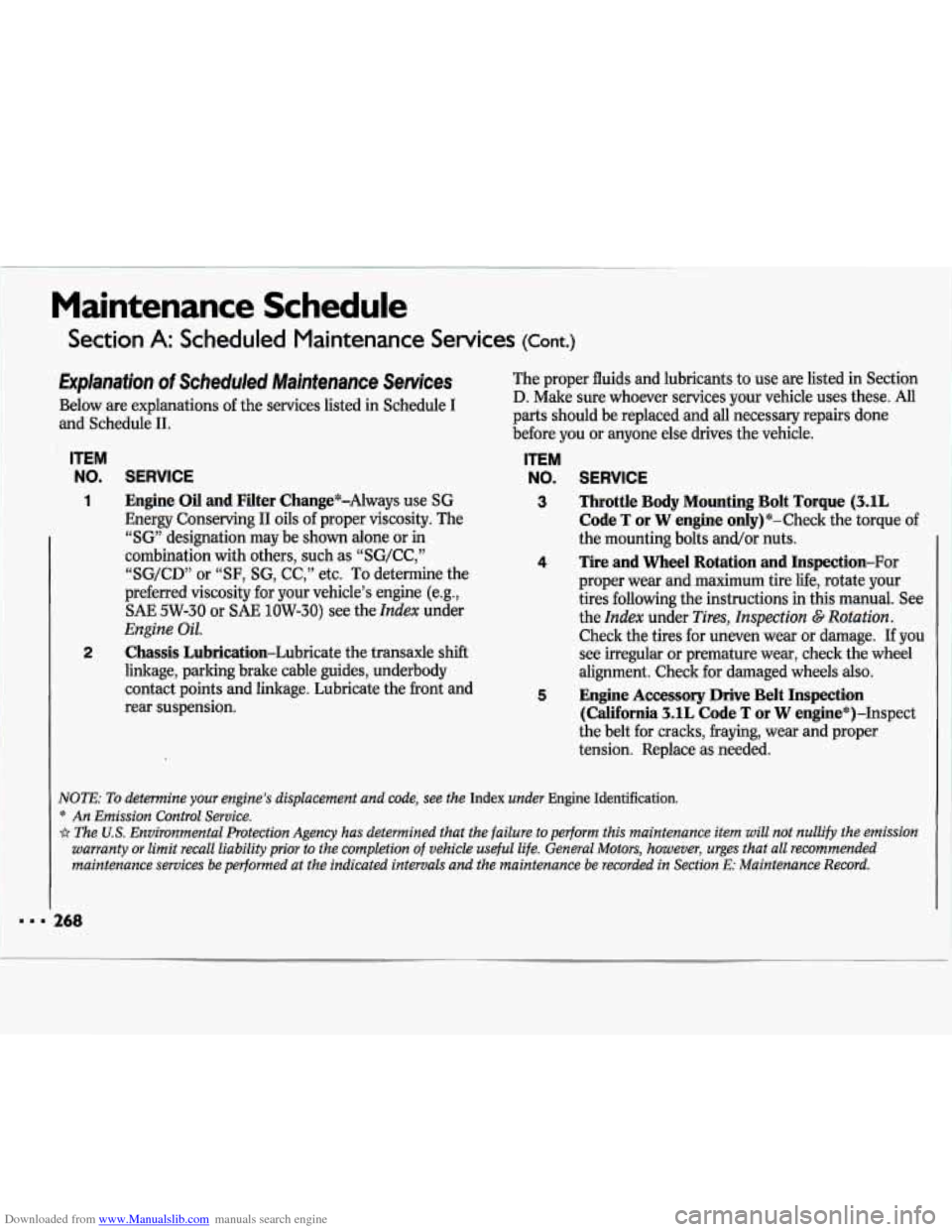
Downloaded from www.Manualslib.com manuals search engine Maintenance Schedule
Section A: Scheduled Maintenance Services (cont.)
Explanation of Scheduled Maintenance Services
Below are explanations of the services listed in Schedule I
and Schedule 11. The proper fluids and
lubricants to use are listed in Section
D. Make sure whoever services your vehicle uses these. All
parts should be replaced and all necessary repairs done
before you or anyone else drives the vehicle.
ITEM
NO.
1
2
SERVICE
Engine Oil and Filter Change*-Always use SG
Energy Conserving I1 oils of proper viscosity. The
“SG” designation may be shown alone or in
combination with others, such as “SG/CC,”
“SG/CD” or “SF, SG, CC,” etc. To determine the
preferred viscosity for your vehicle’s engine
(e.g.,
SAE 5W-30 or SAE 1OW-30) see the Index under
Engine Oil.
Chassis Lubrication-Lubricate the transaxle shift
linkage, parking brake cable guides, underbody contact points and linkage. Lubricate the front and
rear suspension.
ITEM
NO. SERVICE
3 Throttle Body Mounting Bolt Torque (3.1L
Code T or W engine only)*-Check the torque of
the mounting bolts and/or nuts.
4 Tire and Wheel Rotation and Inspection-For
proper wear and maximum tire life, rotate your
tires following the instructions in this manual. See
the
Index under Tires, Inspection G Rotation.
Check the tires for uneven wear or damage. If you
see irregular or premature wear, check the wheel
alignment. Check for damaged wheels also.
NOTE: To determine your engine’s displacement and code, see the Index under Engine Identification.
* An Emission Control Service.
* The US. Environmental Protection Agency has determined that the failure \
to perform this maintenance item will not nullify the emission
warranty
or limit recall liability prior to the completion of vehicle useful life. General Motors, however, urges that all recommended
maintenance services be performed at the indicated intervals and\
the maintenance be recorded in Section
E: Maintenance Record.
5 Engine Accessory Drive Belt Inspection
(California 3.1L Code T
or W engine*)-Inspect 1
the belt for cracks, fraying, wear and proper
tension. Replace as needed.
Page 271 of 324
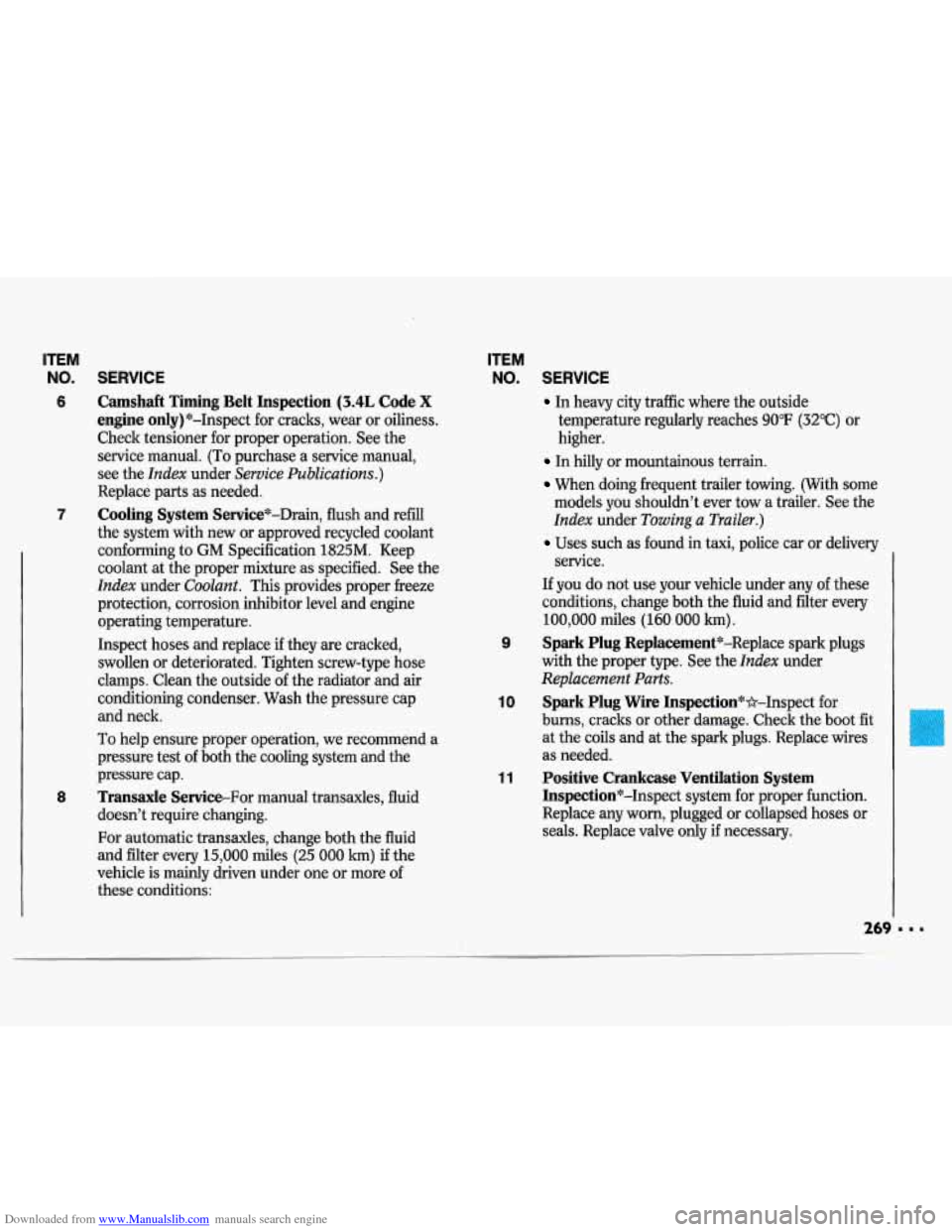
Downloaded from www.Manualslib.com manuals search engine ITEM
NO. SERVICE
6 Camshaft Timing Belt Inspection (3.4L Code X
engine only)*-Inspect for cracks, wear or oiliness.
Check tensioner for proper operation. See the
service manual.
(To purchase a service manual,
see the
Index under Service Publications.)
Replace parts as needed.
Cooling System Service*-Drain, flush and refill
the system with new or approved recycled coolant
conforming to
GM Specification 1825M. Keep
coolant at the proper mixture as specified. See the
Index under Coolant. This provides proper freeze
protection, corrosion inhibitor level and engine
operating temperature.
7
8
Inspect hoses and replace if they are cracked,
swollen or deteriorated. Tighten screw-type hose
clamps. Clean the outside of the radiator and air
conditioning condenser. Wash the pressure cap
and neck.
To help ensure proper operation, we recommend a
pressure test of both the cooling system and the
pressure cap.
Transaxle Service-For manual transaxles, fluid
doesn’t require changing.
For automatic transaxles, change both the fluid
and filter every 15,000 miles (25
000 km) if the
vehicle is mainly driven under one or more
of
these conditions:
ITEM
NO.
9
10
11
SERVICE
In heavy city traffic where the outside
temperature regularly reaches
90°F (32°C) or
higher.
In hilly or mountainous terrain.
When doing frequent trailer towing. (With some
models you shouldn’t ever tow a trailer. See the
Index under Towing a Trailer.)
Uses such as found in taxi, police car or delivery
service.
If you do not use your vehicle under any of these
conditions, change both the fluid and filter every
100,000 miles
(160 000 km).
Spark Plug Replacement*-Replace spark plugs
with the proper type. See the
Index under
Replacement Parts.
Spark Plug Wire Inspection*+Inspect for
burns, cracks
or other damage. Check the boot fit
at the coils and at the spark plugs. Replace wires
as needed.
Positive Crankcase Ventilation System
Inspection*-Inspect system for proper function.
Replace any
worn, plugged or collapsed hoses or
seals. Replace valve only if necessary.
269 .
Page 273 of 324

Downloaded from www.Manualslib.com manuals search engine Section B: Owner Checks & Services
Listed below are owner checks and services which should
be made at the intervals specified to help ensure the safety,
dependability and emission control performance of your
vehicle. Be
sure any necessary repairs are completed at once.
Whenever any fluids or lubricants are added to your vehicle,
make sure they are the proper ones, as
shown in Section D.
At Each he/ H// (It is important for you or a service station attendant to pe&m these underhood checks at each fuel fill.)
CHECK
I I Engine Coolant Level
I
Windshield Washer
Fluid Level
1 At Least Once a Month
WHAT TO DO
Check the engine oil level and add the proper oil if necessary. See the Index under Engine Oil for
further details.
Check the engine coolant level in the coolant recovery
tank and add the proper coolant mix if
necessary.
See the Index under Coolurzt for further details.
Check the windshield washer fluid level in the windshield washer tank and add the proper fluid
if necessary. See the Index under Windshield Washer Fluid for further details.
CHECK
I I OR SERVICE
Tire Inflation
I At Least Twice a bar
WHAT TO DO I
Check tire inflation. Make sure they are inflated to the pressures specified on the Tire-Loading
Information label located on the rear edge of the driver's door or inside the trunk lid.
See the
Inda under Tires for further details.
IL .I
CHECK
System Inspection
WHAT TO DO
Check the fluid level in the clutch reservoir. See the Iinda under Hydraulic Clutch. A fluid loss
in this system could indicate a problem. Have the system inspected and \
repaired at once.
27 I
Page 274 of 324

Downloaded from www.Manualslib.com manuals search engine Maintenance Schedule
Section B: Owner Checks & Services (Cant.)
At Least Once a Bar
CHECK
OR SERVICE WHAT TO DO
Key Lock Cylinders Lubricate the key lock cylinders with the lubricant specified in Section D.
Body Lubrication Lubricate all body door hinges. Also lubricate all hinges and latches, including those for thc
hood, trunk, glove box door, console door and any folding seat hardware. Section
D tells you
what to use.
~~~
Starter Switch
I
It
When you are doing this check, the vehicle could move suddenly. If it does,\
you or others
could be injured. Follow the steps below.
I. Before: you sum, ot; sure you IldVG GIlUUgl mu111 dound the vehiclt;.
2. Firmly apply both the parking brake (see the Ida under Parking Brake if necessary) and the
regular brake.
NOTE:
Do not use the accelerator pedal, and be ready to turn off the engine immediately if it
Starts.
3. On automatic transaxle vehicles, try to start the engine in each gear. The starter should work
only
in P (Park) or N (Neutral). If the starter works in any other position, your vehicle needs
service.
On manual transaxle vehicles, put the shift lever
in N (Neutral), push the clutch down halfway
and
try to start the engine. The starter should work only when the clutch is pushed down all
the way to the floor. If the starter works when the clutch isn’t pushed all the way down, your
vehicle needs service.
ll 1
Page 275 of 324

Downloaded from www.Manualslib.com manuals search engine CHECK
OR SERVICE I WHAT TO DO
While parked, and with the parking brake set, try to turn the key to Lock in each shift lever
position.
With an automatic transaxle, the key should turn to Lock only when the shift lever is in
With a manual transaxle, the key should turn to Lock only when the shift lever is in
On vehicles with a key release button, try to turn the key to
Lock without pressing the button.
The key should turn to
Lock only with the key button depressed. On all vehicles, the key should
come out
only in Lock.
P (Park).
R (Reverse).
I
Parking Brake and
Automatic Transaxle
P (Park) Mechanism A When you are doing this check, your vehicle could begin to move. You or others could be
Check - injured and property could be damaged. Make sure there is room in front of your vehicle
I
in case it begins to roll. Be ready to apply the regular brake at once should the vehicl\
e begin to I
Underbody Flushing move.
- -
EUK on a
ramy steep mu, with the vehicle iac~ downhill. E - lg you - - on the regular
brake, set the parking brake.
To check the parking brake: With the engine running and the transaxle in N (Neutral), slowly
remove foot pressure from the regular brake pedal.
Do this until the vehicle is held by the
parking brake only.
To check the P (Park) mechanism’s holding ability: Shift to P (Park). Then release all brakes.
At least every spring, use plain water to flush any corrosive materials from the underbody. Take
care to clean thoroughly any areas where mud and other debris can collect.
-
I